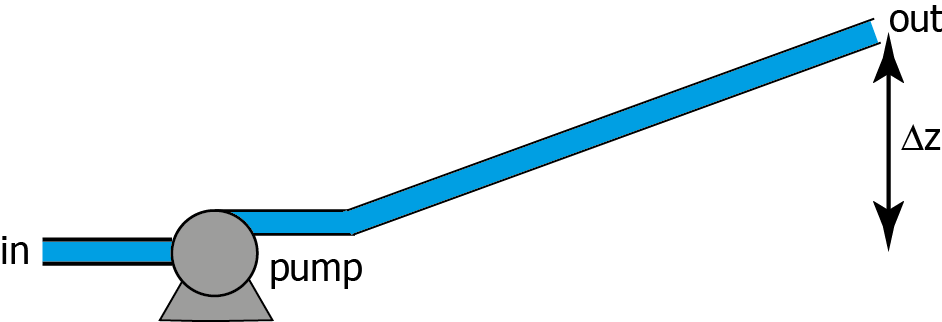2.3 The mechanical energy balance Bernoulli’s law: examples
Course subject(s)
2. Energy balances
EXAMPLE 2.3A: NARROWING TUBE (ELEMENTARY)
A horizontal, cylindrical, straight tube has an internal diameter of 2″. At some point, the diameter narrows down to only 1″. Water flows through the tube at a flow rate of 10 liter/min. The pressure in the 2″ part is 1.1bar. In this exercise, we neglect frictional effects. The situation is in steady state.
- Compute the velocity in the 2″ part.
- Use a mass balance to compute the velocity in the 1″ part.
- Use Bernoulli’s law to calculate the pressure in the 1″ part.
Example 2.3A: Narrowing tube (elementary)
Sorry but there don't seem to be any downloads..
Subtitles (captions) in other languages than provided can be viewed at YouTube. Select your language in the CC-button of YouTube.
EXAMPLE 2.3B: PUMPING POWER (MEDIUM)
A pump is used to pump water up a hill to a height of 200m. The mass flow rate of water is 2kg/s. The pipe through which the water is flowing has a diamater of 2″. Water enters the pump at atmospheric pressure, and leaves the pipe at atmospheric pressure. At the end of the pipe, the water temperature is 0.05o warmer than it entered, due to friction.

The water temperature is 20oC. The situation is in steady state.
- Compute the required power of the pump (assuming 100% efficiency of the pump) ignoring the warming up of the water.
- Compute the required power of the pump (assuming 100% efficiency of the pump) including the warming up of the water.
Example 2.3B: Pumping power (medium)
Sorry but there don't seem to be any downloads..
Subtitles (captions) in other languages than provided can be viewed at YouTube. Select your language in the CC-button of YouTube.
EXAMPLE 2.3C: LEAKING BUCKET (ADVANCED)
You happen to have a bucket with a small hole in the bottom area (1 cm above the actual bottom). Obviously, if you fill the bucket with water, it will flow out through the hole. The question here is: how fast does it leave the bucket, and can we use this as a first estimate of how much time we have before the bucket is empty?
Data:
- Bucket volume 5 liter of water;
- height of water in the bucket: 30cm;
- height of hole above bottom: 1cm;
- hole diameter: 4mm.
Example 2.3C: Leaking bucket (advanced)
Sorry but there don't seem to be any downloads..
Subtitles (captions) in other languages than provided can be viewed at YouTube. Select your language in the CC-button of YouTube.

The Basics of transport phenomena by TU Delft OpenCourseWare is licensed under a Creative Commons Attribution-NonCommercial-ShareAlike 4.0 International License.
Based on a work at https://ocw.tudelft.nl/courses/basics-transport-phenomena/.



